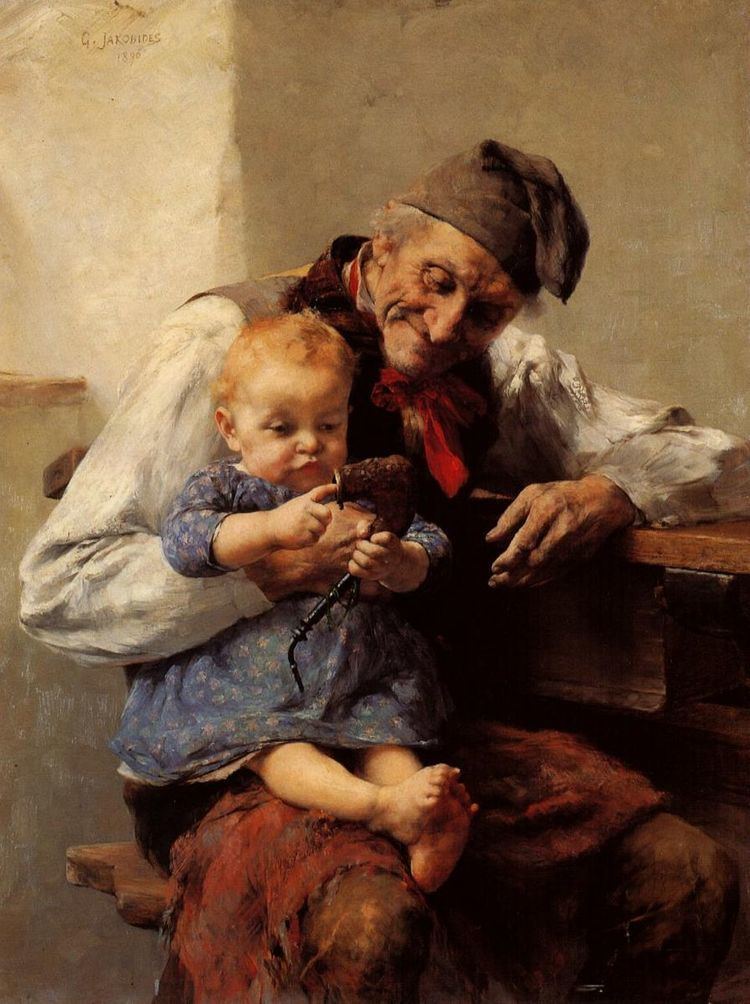 | ||
Grandparents are the parents of a person's father or mother – paternal or maternal. Every sexually-reproducing creature who is not a genetic chimera has a maximum of four genetic grandparents, eight genetic great-grandparents, sixteen genetic great-great-grandparents, 32 genetic great-great-great-grandparents, 64 genetic great-great-great-great-grandparents, etc., although the numbers will be lower in cases of pedigree collapse. In the history of modern humanity, around 30,000 years ago, the number of modern humans who lived to be grandparents increased exponentially. It is not known for certain what spurred this increase in longevity, but it is generally believed that a key consequence of three generations being alive together was the preservation of information which could otherwise have been lost; an example of this important information might have been where to find water in times of drought.
Contents
In cases where parents are unwilling or unable to provide adequate care for their children (e.g., death of the parents), grandparents often take on the role of primary caregivers. Even when this is not the case, and particularly in traditional cultures, grandparents often have a direct and clear role in relation to the raising, care and nurture of children. Grandparents are second-degree relatives and share 25% genetic overlap.
A step-grandparent can be the step-parent of the parent or the step-parent's parent or the step-parent's step-parent (though technically this might be called a step-step-grandparent). The various words for grandparents at times may also be used to refer to any elderly person, especially the terms gramps, granny, grandfather, grandmother and others which families make up themselves.
The youngest grandmother in the world is Rifca Stănescu, a Romani girl from Romania, who at the age of 12 gave birth to her first child, a girl called Maria. Maria, in her turn, gave birth to a child at the age of 11, thus making her mother Rifca - the youngest grandmother in the world at the age of just 23 years.
Titles
When used as a noun (e.g., "... a grandparent walked by"), grandfather and grandmother are usually used, although forms such as grandma/grandpa, granny/granddaddy or even nan/pop are sometimes used. When preceded by "my ..." (e.g., "... my grandpa walked by"), all forms are common (anywhere from "... my grandfather ..." to "... my Gramps ..."). All forms can be used in plural, but Gramps (plural Gramps) is rare.
In writing, Grandfather and Grandmother are most common, but very rare when referring to a grandparent in person. In speech, Grandpa and Grandma are commonly used in the United States, Canada and Australia. In Britain, Ireland, United States, Australia, New Zealand and, particularly prevalent in Newfoundland and Labrador, Nan, Nana, Nanan, Nannan, Nanna, Nada, Nanny, Gran and Granny and other variations are often used for grandmother in both writing and speech.
In many parts of Pakistan and India, maternal grandparents are called Nana and Nani. Similarly, paternal grandparents are called Dada and Dadi.
Numerous other variants exist, such as Gramp, Gramps, Grampa, Grandpap, Granda, Grampy, Granddad, Granddaddy, Grandpappy, Pop(s), Pap, Pappy, and Pawpaw for grandfather; Grandmom, Grandmama, Granny; Gran, Nanny, Nan, Mammaw and Grammy for grandmother. Gogo can be used for either, etc.
Given that people may have two living sets of grandparents, some confusion arises from calling two people "grandma" or "grandpa", so often two of the other terms listed above are used for one set of grandparents. Another common solution is to call grandparents by their first names ("Grandpa George", "Grandma Anne", etc.) or by their family names ("Grandpa Jones", "Grandma Smith"). In North America, many families call one set of grandparents by their ethnic names (e.g., Hispanic grandparents might be called abuelo and abuela or "abuelito" and "abuelita", French grandparents might be called papi and mamie, Italian grandparents might be called nonno and nonna, or Dutch and German grandparents might be called Opa and Oma. In Flanders pepee or petje and memee or metje are most used). Mandarin-speaking Chinese Americans refer to maternal grandparents as pó pó (婆婆) and gōng gōng (公公) and paternal grandparents as nǎi nǎi (奶奶) and yé yé (爷爷). In the Philippines, grandparents are called lolo (grandfather) and lola (grandmother), respectively.
Languages and cultures with more specific kinship terminology than English may distinguish between paternal grandparents and maternal grandparents. For example, in the Swedish language there is no single word for "grandmother"; the mother's mother is termed mormor and the father's mother is termed farmor. However, the other Scandinavian languages, Danish and Norwegian, use words which specifies the kinship like in Swedish (identically spelled among all three languages), as well as using common terms similar to grandmother (Danish: bedstemor, Norwegian: bestemor).
Great-grandparents
The parents of a grandparent, or the grandparents of a parent are called all the same names (grandfather/-mother, grandpa/-ma, granddad/-ma, etc.) with the prefix great- added, one for each additional generation. One's great-grandparent's parents would be "great-great-grandparents".
To avoid a proliferation of "greats" when discussing genealogical trees, one may also use ordinals instead of multiple "greats"; thus a "great-great-grandfather" would be the "second great-grandfather", and a "great-great-great-grandfather" would be a third great-grandfather, and so on. This system is used by some genealogical websites such as Geni. One may also use cardinal numbers for numbering greats, for example, great-great-great-great-great-great-grandmother becomes 6×-great-grandma.
Individuals who share the same great-grandparents but are not siblings or first cousins are called "second cousins" to each other, as second cousins are the grandchildren of one's grandparent's siblings.
History of the term
The use of the prefix "grand-" dates from the early 13th century, from the Anglo-French graund. The term was used as a translation of Latin magnus. The prefix "great-" represents a direct translation of magnus to English. In Old English, the prefixes ealde- (old) and ieldra- (elder) were used (ealdefæder/-mōdor and ieldrafæder/-mōdor). A great-grandfather was called a þridda fæder (third father), a great-great-grandfather a fēowerða fæder (fourth father), etc.
